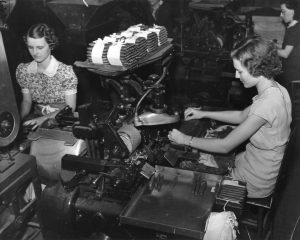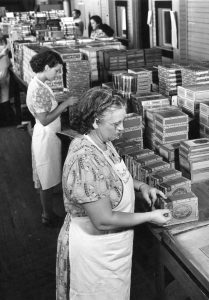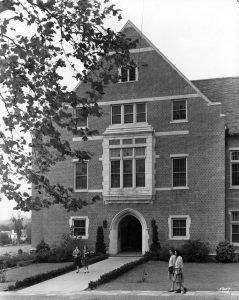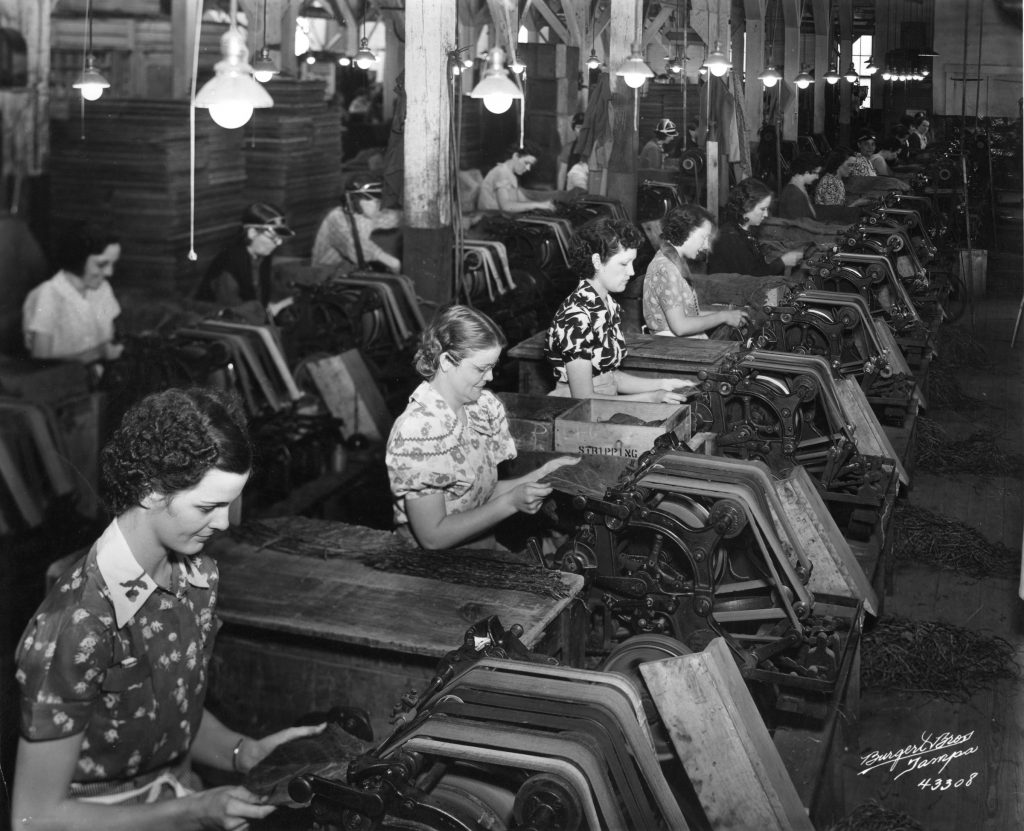The Burgert Brothers Collection of Tampa Photographs pictorially captures the history of our city during the first half of the twentieth century. From 1917 until the 1960s, Burgert Brothers was the leading commercial photographic firm in Tampa. The photographs in this collection focus on communities at work and at play. From grocery stores, cigar factories, and cargo ships to citrus fields, universities, and company buildings, this collection provides a look at a changing society. Documenting Tampa in times of war, economic booms, cultural changes, and economic hardships, this collection shows how a marginalized group could enter into new spaces and flourish. With 863 digitized items, Digital Dialogs would like to celebrate Women’s History Month with the Burgert Brothers’ Collection in recognition of its many depictions of women at work and women’s collegiate education.
Working Women

As their photographs show, Ybor City, the cigar capital of the world, provided many subjects for Burgert Brothers. Cigar and cigarette factories became a major industry in the area, employing countless female workers by the beginning of the 20th century. Working largely as bunch makers, cigar makers, rollers, and labelers, female workers began to “outnumber men in the trade.”[1] U.S. census data shows that in 1900, women made up 37.8% of all cigar and cigarette factory workers.[1] By 1919, that number jumped to 58.9%.[1]
In these factories, women faced quite a few challenges, including difficult working conditions, harassment, and prejudice from male unionists. Both female and male employees worked in hot, “dusty, poorly ventilated, and crowded” spaces.[1] In some factories, these conditions were exacerbated by the fact that workers were not usually permitted to open windows as it would dry out the tobacco.[1]

In addition, women frequently received a lower wage than men, causing some “male unionists [to fear] that women would lower their own wages or even turn them out of a job.”[1] This fear was fueled by the American culture of the early 20th century. At the time, there was often a pervading notion of women’s inferiority, so that “when women performed essentially the same work as men, masculine culture interpreted it as degrading, undignified, and dishonorable.”[1] On the whole, male unionists did not treat women as equals, “often depict[ing] [women] as needy, vulnerable, and victimized, suggesting that many women cigar makers were prostitutes because they needed the money.”[1]
Even in light of these difficult circumstances, female workers persevered. For women, “community and work intersected and often reinforced each other.”[1] As a result, more and more women entered the workforce, helping to provide for their families. Recently, scholars have “begun to document a rich associational life amoung working-class women, a web of ties and networks which contrasted to the isolation of the home.”[1]
Women’s Collegiate Education

While women were finding jobs in Tampa, careers were another matter. A woman with career aspirations was a relatively new concept, even into the second half of the 20th century.[2] Traditionally, men “would attend college in the hopes of pursuing a career” while “women were expected to remain in the home and raise children, which was work, but not a career.”[2] For most women, jobs were considered temporary without a “distinct future, but a career is a path in which individuals build on their experiences to create a holistic story.”[2] The fight against sexism in higher education and in the workplace was “a difficult battle because the idea of the women’s role in the home and as a caretaker was deeply ingrained in United States society.”[2]
A woman’s participation in higher education was influenced by many factors, including marriage status, social norms, race, and access to adequate primary and secondary education.[2] With a total population of 76 million people[3], just 5,237 women obtained a bachelor’s degree in 1900 while 22,173 men earned bachelor’s degrees in the United States.[4] By 1930, the population had grown to 122.8 million with 480,802 women enrolled in college and 48,869 earning bachelor’s degrees.[4]
While the number of female college students was on the rise, race and economic status created numerous challenges for young women. A study in 1933 showed that “41 percent of African American high school age students in 425 counties had either no high school facilities or facilities not equivalent to a four-year high school.”[4] A different study showed that in 15 states, “there were three whites for each African American in the general population [while] there were nine white students for every African American in public colleges and universities in those states.”[4] By the late 1960s, gradually increasing divorce rates compelled more and more “women to seek self-sufficiency [and] a college education provide[d] a higher probability of an economically stable future and occupation.”[2]

For women, low enrollment rates were largely due to the cultural norms of the day and a general lack of opportunity, rather than a lack of interest or intellect. The women pictured in the Burgert Brothers’ photographs helped to pave the way for future female employees and students by showing the importance of perseverance, determination, and tenacity.
Due to a generous gift from the Frank E. Duckwall Foundation, all of the prints in the Burgert Brothers Collection have been digitized. These items are available through USF Digital Collections.
Explore the Burgert Brothers Collection of Tampa Photographs: https://digital.lib.usf.edu/burgert/all
REFERENCES
[1] Patricia Ann Cooper, Once a Cigar Maker: Men, Women, and Work Culture in American Cigar Factories, 1900-1909 (Urbana and Chicago: University of Illinois Press, 1987), 160-161, 219-220, 222.
[2] “Women, Marriage, Education, and Occupation in the United States from 1940-2000,” History 90.01: Topics in Digital History, Dartmouth University, November 3, 2016, Accessed December 16, 2019, https://journeys.dartmouth.edu/censushistory/2016/11/03/women-marriage-and-education-in-the-united-states-from-1940-2000/.
[3] Frank Hobbs and Nicole Stoops (U.S. Department of Commerce), “Demographic trends in the 20thCentury, Census 2000 Special Reports, November 2002, p. 11 (https://www.census.gov/prod/2002pubs/censr-4.pdf).
[4] Margaret Nash and Lisa Romero, “‘Citizenship for the College Girl’: Challenges and Opportunities in Higher Education for Women in the United States in the 1930s,” Teachers College Record 114, no. 2 (2012): 6.